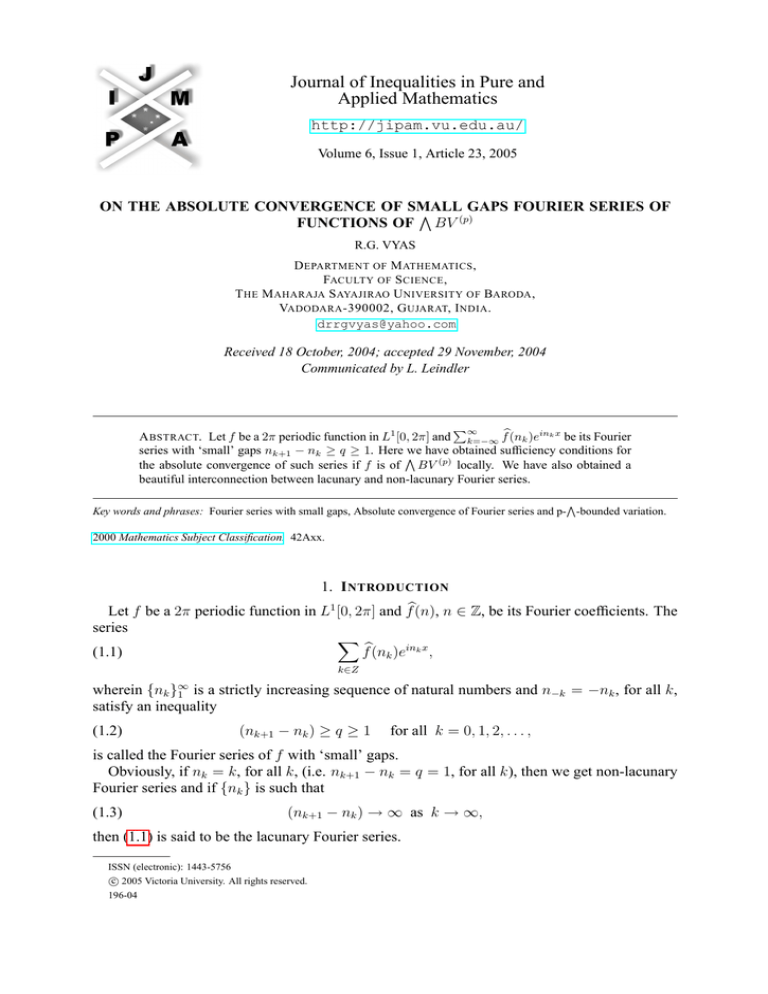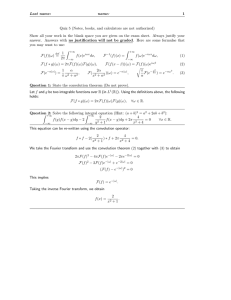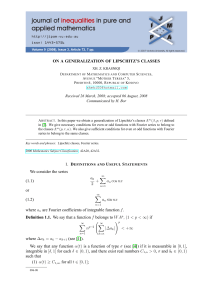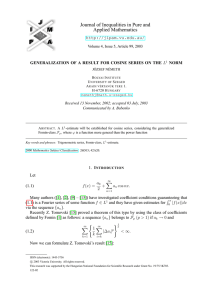
Journal of Inequalities in Pure and
Applied Mathematics
http://jipam.vu.edu.au/
Volume 6, Issue 1, Article 23, 2005
ON THE ABSOLUTE CONVERGENCE OF SMALL
GAPS FOURIER SERIES OF
V
(p)
FUNCTIONS OF BV
R.G. VYAS
D EPARTMENT OF M ATHEMATICS ,
FACULTY OF S CIENCE ,
T HE M AHARAJA S AYAJIRAO U NIVERSITY OF BARODA ,
VADODARA -390002, G UJARAT, I NDIA .
drrgvyas@yahoo.com
Received 18 October, 2004; accepted 29 November, 2004
Communicated by L. Leindler
P∞
A BSTRACT. Let f be a 2π periodic function in L1 [0, 2π] and k=−∞ fb(nk )eink x be its Fourier
series with ‘small’ gaps nk+1 − nk ≥ q ≥ 1. Here V
we have obtained sufficiency conditions for
the absolute convergence of such series if f is of BV (p) locally. We have also obtained a
beautiful interconnection between lacunary and non-lacunary Fourier series.
V
Key words and phrases: Fourier series with small gaps, Absolute convergence of Fourier series and p- -bounded variation.
2000 Mathematics Subject Classification. 42Axx.
1. I NTRODUCTION
Let f be a 2π periodic function in L1 [0, 2π] and fb(n), n ∈ Z, be its Fourier coefficients. The
series
X
(1.1)
fb(nk )eink x ,
k∈Z
wherein {nk }∞
1 is a strictly increasing sequence of natural numbers and n−k = −nk , for all k,
satisfy an inequality
(1.2)
(nk+1 − nk ) ≥ q ≥ 1
for all k = 0, 1, 2, . . . ,
is called the Fourier series of f with ‘small’ gaps.
Obviously, if nk = k, for all k, (i.e. nk+1 − nk = q = 1, for all k), then we get non-lacunary
Fourier series and if {nk } is such that
(1.3)
(nk+1 − nk ) → ∞ as k → ∞,
then (1.1) is said to be the lacunary Fourier series.
ISSN (electronic): 1443-5756
c 2005 Victoria University. All rights reserved.
196-04
2
R.G. V YAS
By applying the Wiener-Ingham result [1, Vol. I, p. 222] for the finite trigonometric sums
with small
condition for the convergence of the series
gap
β (1.2) we have studied the sufficiency
P
V
b
f (nk ) (0 < β ≤ 2) in terms of BV and the modulus of continuity [2, Theorem
k∈Z
3]. Here we haveVgeneralized this result and we have also obtainedVa sufficiency condition if
(p)
function
V f is(p)of BV . In 1980 Shiba [4] generalized the class BV . He introduced the
class BV .
V
Definition 1.1. Given an interval
I,
a
sequence
of
non-decreasing
positive
real
numbers
=
P 1
V
(p)
{λm } (m = 1, 2, . . .) such that m λm diverges and 1 ≤ p < ∞ we say that f ∈ BV (that
V
is f is a function of p − -bounded variation over (I)) if
VΛp (f, I) = sup {VΛp ({Im }, f, I)} < ∞,
{Im }
where
VΛp ({Im }, f, I) =
X |f (bm ) − f (am )|p
m
λm
! p1
,
and {Im } is a sequence of non-overlapping subintervals Im = [am , bm ] ⊂ I = [a, b].
V
Note that, if p = 1, one gets the class BV (I); if λm ≡ 1 for all m, one gets the class
BV (p) ; if p = 1 and λm ≡ m for all m, one gets the class Harmonic BV (I). if p = 1 and
λm ≡ 1 for all m, one gets the class BV (I).
Definition 1.2. For p ≥ 1, the p−integral modulus of continuity ω (p) (δ, f, I) of f over I is
defined as
ω (p) (δ, f, I) = sup k(Th f − f )(x)kp,I ,
0≤h≤δ
where Th f (x) = f (x + h) for all x and k(·)kp,I = k(·)χI kp in which χI is the characteristic
function of I and k(·)kp denotes the Lp -norm. p = ∞ gives the modulus of continuity ω(δ, f, I).
We prove the following theorems.
Theorem 1.1. Let f ∈ L[−π, π] possess
V a Fourier series with ‘small’ gaps (1.2) and I be a
subinterval of length δ1 > 2π
.
If
f
∈
BV (I) and
q
β2
ω( n1k , f, I)
< ∞,
Pnk 1 k
k=1
j=1 λj
∞
X
then
(1.4)
β
X b
f (nk ) < ∞
(0 < β ≤ 2).
k∈Z
P k 1
≥ λnnk and hence our earlier theorem [2,
Since {λj } is non-decreasing, one gets nj=1
λj
k
Theorem 3] follows from Theorem 1.1.
Theorem 1.1 with β = 1 and λn ≡ 1 shows that the Fourier series of f with ‘small’ gaps
condition (1.2) (respectively (1.3)) converges absolutely if the hypothesis of the Stechkin theorem [5, Vol. II, p. 196] is satisfied only in a subinterval of [0, 2π] of length > 2π
(respectively
q
of arbitrary positive length).
J. Inequal. Pure and Appl. Math., 6(1) Art. 23, 2005
http://jipam.vu.edu.au/
A BSOLUTE C ONVERGENCE OF S MALL G APS F OURIER S ERIES OF F UNCTIONS
3
V
Theorem 1.2. Let f and I be as in Theorem 1.1. If f ∈ BV (p) (I), 1 ≤ p < 2r, 1 < r < ∞
and
2−p/r β2
1
((2−p)s+p)
∞
, f, I
X
nk
ω
< ∞,
P r1
n
1
k
k=1
k
j=1 λj
where
1
r
+
1
s
= 1, then (1.4) holds.
Theorem 1.2 with β = 1 is a ‘small’ gaps analogue of the Schramm and Waterman result [3,
Theorem 1].
We need the following lemmas to prove the theorems.
Lemma 1.3 ([2, Lemma 4]). Let f and I be as in Theorem 1.1. If f ∈ L2 (I) then
2
X −1
2
(1.5)
fb(nk ) ≤ Aδ |I| kf k2,I ,
k∈Z
where Aδ depends only on δ.
Lemma 1.4. If |nk | > p then for t ∈ N one has
Z π
p
sin2t |nk | h dh ≥
0
π
2t+1 p
.
Proof. Obvious.
Lemma 1.5 (Stechkin, refer to [6]). If un ≥ 0 for n ∈ N, un 6= 0 and a function F (u) is
concave, increasing, and F (0) = 0, then
∞
∞
X
X
un + un+1 + · · ·
F (un ) ≤ 2
F
.
n
1
1
V
Lemma 1.6. If f ∈ BV (p) (I) implies f is bounded over I.
Proof. Observe that
p
p
|f (x)| ≤ 2
≤ 2p
|f (x) − f (a)|p
|f (b) − f (x)|p
|f (a)| + λ1
+ λ2
λ1
λ2
p
|f (a)| + λ2 V∧p (f, I)
p
Hence the lemma follows.
Proof of Theorem 1.1. Let I = x0 − δ21 , x0 + δ21 for some x0 and δ2 be such that 0 <
δ2 < δ1 . Put δ3 = δ1 − δ2 and J = x0 − δ22 , x0 + δ22 . Suppose integers T and j satisfy
2π
q
<
4π
δ3 |nT |
and 0 ≤ j ≤
.
δ3
4π
V
Since f ∈ BV (I) implies f is bounded over I by Lemma 1.6 (for p = 1), we have f ∈ L2 (I),
so that (1.5) holds and f ∈ L2 [−π, π]. If we put fj = (T2jh f − T(2j−1)h f ) then fj ∈ L2 (I) and
the Fourier series of fj also possesses gaps (1.2). Hence by Lemma 1.3 we get
2
X nk h
2
2
ˆ
(1.7)
= O kfj k2,J
f (nk ) sin
2
k∈Z
(1.6)
|nT | >
because
1
fˆj (nk ) = 2ifˆ(nk )eink (2j− 2 h) sin
J. Inequal. Pure and Appl. Math., 6(1) Art. 23, 2005
nk h
2
.
http://jipam.vu.edu.au/
4
R.G. V YAS
Integrating both the sides of (1.7) over (0, nπT ) with respect to h and using Lemma 1.4, we get
Z
∞
2
X
ˆ
f (nk ) = O(nT )
(1.8)
Multiplying both the sides of the equation by
(1.9)
k fj k22,J dh.
0
|nk |≥nT
X 1
λj
j
π
nT
1
λj
and then taking summation over j, we get
!
Z
∞
2
X
fˆ(nk ) = O(nT )
π
nT
0
|nk |≥nT
X |f |2 j
λ
j
j
dh.
1,J
Now, since x ∈ J and h ∈ (0, nπT ) we have |fj (x)| = O(ω( n1T , f, I)), for each j of the
V
P |f (x)|
summation; since x ∈ J and f ∈ BV (I) we have j jλj = O(1) because for each j the
points x + 2jh and x + (2j − 1)h lie in I for h ∈ (0, nπT ) and x ∈ J ⊂ I. Therefore
X |fj (x)|2
!
λj
j
!
X
1
|fj (x)|
=O ω
, f, I
nT
λj
j
1
=O ω
, f, I
.
nT
It follows now from (1.9) that
RnT
1
2
ω
,
f,
I
X nT
=
fˆ(nk ) = O PnT 1 .
j=1 λj
|nk ≥nT
2
Finally, Lemma 1.5 with uk = fˆ(nk ) (k ∈ Z) and F (u) = uβ/2 gives
∞ ∞
β
2 X
X
ˆ
ˆ
F f (nk )
f (nk ) = 2
|k|=1
k=1
≤4
≤4
∞
X
F
k=1
∞ X
k=1
= O(1)
This proves the theorem.
Rnk
k
β/2
Rnk
k
∞
X
ω( n1k , f, I)
k=1
1
k
k(Σnj=1
)
λj
!(β/2)
.
V
Proof of Theorem 1.2. Since f ∈ BV (p) (I), Lemma 1.6 implies f is bounded over I. Therefore f ∈ L2 (I), and hence (1.5) holds so that f ∈ L2 [−π, π]. Using the notations and procedure
+ pr , by using Hölder’s inequality, we get from
of Theorem 1.1 we get (1.9). Since 2 = (2−p)s+p
s
J. Inequal. Pure and Appl. Math., 6(1) Art. 23, 2005
http://jipam.vu.edu.au/
A BSOLUTE C ONVERGENCE OF S MALL G APS F OURIER S ERIES OF F UNCTIONS
5
(1.9)
Z
Z
2
(2−p)s+p
|fj (x)| dx ≤
|fj (x)|
J
1s Z
≤
r1
|fj (x)| dx
dx
J
1/r
Ωh,J
p
J
Z
p
r1
|fj (x)| dx
,
J
where Ωh,J = (ω (2−p)s+p (h, f, J))2r−p .
This together with (1.9) implies, putting
2
X nk h
2
b
,
B=
f (nk ) sin
2
k∈Z
that
B≤
1/r
Ωh,J
Z
r1
p
|fj (x)| dx
.
J
Thus
Z
r
B ≤ Ωh,J
p
|fj (x)| dx .
J
Now multiplying both the sides of the equation by λ1j and then taking the summation over j = 1
to nT (T ∈ N) we get
R P
|fj (x)|p
Ωh,J J
dx
j
λj
P 1
Br ≤
.
j λj
Therefore
Ω
Ph,J1
B≤
! r1
Z
J
j λj
X |fj (x)|p
j
λj
! r1
!
dx
.
Substituting back the value of B and then integrating both the sides of the equation with respect
to h over (0, nπT ), we get
(1.10)
k∈Z
π/nT
|nk | h
sin
dh
2
0
r1
Z π/nT
Ω1/nT ,J
=O
P
2 Z
X fb(nk )
2
1
j λj
0
Z
X |fj (x)|p
J
λj
j
! r1
!
dx
dh.
Observe that for x in J, h in (0, nπT ) and for each j of the summation the points x + 2jh and
V
x + (2j − 1)h lie in I; moreover,f ∈ BV (p) (I) implies
X |fj (x)|p
= O(1).
λ
j
j
Therefore, it follows from (1.10) and Lemma 1.4 that
RnT
2
X ≡
fb(nk ) = O
|nk |≥nT
J. Inequal. Pure and Appl. Math., 6(1) Art. 23, 2005
Ω1/n ,I
PnT T 1
! r1
.
j=1 λj
http://jipam.vu.edu.au/
6
R.G. V YAS
Thus
ω
RnT = O
(2−p)s+p
P
1
nT
, f, I
r1
nT 1
j=1 λj
2−p/r
.
Now proceeding as in the proof of Theorem 1.1, the theorem is proved using Lemma 1.5.
R EFERENCES
[1] A. ZYMUND, Trigonometric Series, 2nd ed., Cambridge Univ. Press, Cambridge, 1979 (reprint).
[2] J.R. PATADIA AND R.G. VYAS, Fourier series with small gaps and functions of generalized variations, J. Math. Anal. and Appl., 182(1) (1994), 113–126.
[3] V
M. SCHRAM AND
V D. WATERMAN, Absolute convergence of Fourier series of functions of
(p)
BV
and Φ BV , Acta. Math. Hungar, 40 (1982), 273–276.
V
[4] M. SHIBA, On the absolute convergence of Fourier series of functions of class BV (p) , Sci. Rep.
Fukushima Univ., 30 (1980), 7–10.
[5] N.K. BARRY, A Treatise on Trigonometric Series, Pergamon, New York,1964.
[6] N.V. PATEL AND V.M. SHAH, A note on the absolute convergence of lacunary Fourier series, Proc.
Amer. Math. Soc., 93 (1985), 433–439.
J. Inequal. Pure and Appl. Math., 6(1) Art. 23, 2005
http://jipam.vu.edu.au/









